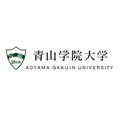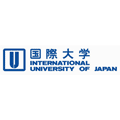Masters Degrees, Graduate Studies and Professional Programs in Japan

Aoyama Gakuin University (AGU)
Tokyo, Japan
Aoyama Gakuin University is a Japanese Christian university based in Shibuya near Tokyo, Japan. The school is part of a comprehensive educational institute called Aoyama Gakuin. The institution consists of a kindergarten, an elementary school, junior and senior high schools, and a women's junior college. The university itself was founded in 1874 to currently offer undergraduate and graduate opportunities in literature, law, economics, business, international politics, economics and communication, science and engineering, cultural and creative studies. The university also has specialized... See full description.

International University of Japan
Niigata, Japan
Located in the city of Niigata, the International University of Japan (IUJ) is a renowned institution of higher learning offering graduate programs leading to Masters Degrees in several subject areas under two graduate schools: the Graduate School of International Relations (GSIR) and the Graduate School of International Management (GSIM).
History of the International University of Japan
Below is a timeline highlighting the history of the International University of Japan:
1976- The Foundation for the Establishment of the International University of Japan was... See full description.

Kyoto University
Kyoto, Japan
Kyoto University was founded in 1897. Currently consists of 10 faculties and students are about 23,000. Of them, about 1,500, come from other countries. This University is considered one of the most prestigious in the world.

The University of Tokyo
Tokyo, Japan
The University of Tokyo is known as "Todai" in Japan, according to abbreviated characters and is considered one of the most prestigious in the world.

Tokyo Business School
Tokyo, Japan
The Tokyo Business School is a private university, part of the United International Business Schools organization, that offers flexible business and management studies at the Undergraduate/Bachelor/BBA, Graduate/Master/MBA, Executive/EBBA/EMBA/EDBA levels in a small-scale, cross-cultural and English-speaking environment.
Undergraduate/Bachelor/BBA, Graduate/Master/MBA, Executive/EBBA/EMBA/EDBA, Business Administration, Economics.
Masters Degrees, Graduate Studies and Professional Programs in Japan by City:
KyotoNagoyaNiigataTokyoYamanashiAbout Masters Degrees, Graduate Studies and Professional Programs in Japan
Upon earning their undergraduate degree, students have a number of options they can pursue after graduation. Some students may opt to commence with their career, while others may choose to augment their educational resume by pursuing some type of graduate degree or upper-division certification. Those who choose the latter option can add some adventure to their educational pursuits by electing to participate in a study abroad program of some kind, such as those offered in the exotic country of Japan.
Japan, or in official circles, the State of Japan, is an island nation situated in Eastern Asia. Located in the Pacific Ocean, the country is positioned to the east of the Sea of Japan, China, North Korea, South Korea and Russia, stretching from the Sea of Okhotsk in the north to the East China Sea and Taiwan in the south. The characters that make up Japan's name mean "sun-origin," which is why Japan is often referred to as the "Land of the Rising Sun."
Japan is a archipelago consisting of 6,852 islands. The four largest islands are Honshu, Hokkaido, Kyushu, and Shikoku, which together comprise about ninety-seven percent of Japan's total land area. Due to its location in the Pacific Ring of Fire, Japan is substantially prone to earthquakes and tsunamis, having the highest natural disaster risk in the developed world. Japan is home to the tenth-largest population on the globe, with over 126 million inhabitants. Honshu’s Greater Tokyo Area, which includes the de facto capital of Tokyo and several surrounding prefectures, is the largest metropolitan area in the world, with over 30 million residents.
Japan is a highly developed country and has the world's third-largest economy by nominal GDP and the world's fourth-largest economy by purchasing power parity. It is also the world's fourth-largest exporter and fourth-largest importer of goods. Much of the reason for the country’s economic success can be attributed to its excellent system of education, including its higher education system, which consistently ranks as one of the best in the world.
Higher Education and Master’s Degree Programs in Japan
Higher education in Japan differs somewhat from that of other developed countries. Some of the chief differences include the method of acceptance into Japanese colleges and universities, which relies almost entirely on one or two tests, as opposed to Grade Point Averages (GPAs) or other methods of assessment. Because students only have a single chance to take this test each year, there is a colossal amount of pressure to perform well on the exam, and the majority of senior high school education is dedicated to preparing students to take this one test.
Another key difference is graduate school. In Japan, very few non-science undergraduate students go to graduate school. This is because graduate schools for non-science students are generally considered useful only for those who want to work in academia.
Unlike higher education in some other developed countries, public universities in Japan are generally regarded as more prestigious than private universities, especially the seven National Universities: University of Tokyo, Kyoto University, Tohoku University, Kyushu University, Hokkaido University, Osaka University, and Nagoya University— representing one university for each major region of Japan.
Japanese higher education consists of universities, junior colleges, colleges of technology, and specialized training colleges. The number of students who continue their study at universities is currently on a decline in response to the falling birth rate. Recently, the demand/supply ratio for new graduates has passed 2, and Japanese graduates may now choose between at least 2 employers for their first job.
The term of study at Japanese universities is usually four years. The exceptions are courses for medicine, dentistry and veterinary medicine, which require at least 6 years of education and training.
According to the Ministry of Education, Culture, Sports, Science and Technology, there are 87 universities in Japan that are managed by the central government, 86 public universities managed by local governments, and 553 private universities.
The academic year at Japan’s higher education institutions begins in April. Different qualifications will apply depending on the level of study and types of institutions.
Various types of scholarships are available for international students for their study and research in Japan.
Hiroshima Peace Memorial
The Hiroshima Peace Memorial is a haunting tribute to the lives lost when the atomic bomb was dropped on Hiroshima on August 6, 1945. Set in an expansive park, the memorial features the Genbaku Dome, the only building left standing in the vicinity after the bomb was dropped. This harsh memento of a world at war reminds visitors of the importance of human life and honors the victims so they will never be forgotten.
Jigokudani Monkey Park
Jigokudani Monkey Park is a famous hot springs area near the city of Nagano. The name Jigokudani (meaning “Hell’s Valley”), is due to the steam and boiling water that bubbles up from the frozen ground, surrounded by steep cliffs and formidably cold forests. It is famous for its large population of wild Snow Monkeys that go to the valley during the winter when snow covers the park. The monkeys descend from the steep cliffs and forest to sit in the warm hot springs, and return to the security of the forests in the evenings.
Kiyomizu-dera
The Kiyomizu-dera Buddhist temple is located in Eastern Kyoto and can be traced back as far as the year 798 AD. An indoor waterfall fed from the outside river helps to keep the temple in harmony with nature and not one nail was used in its construction. While locals used to jump off the edge of the temple (with a survival rate of 85.4%) in hopes of having a wish granted, modern visitors can enjoy the shrines, talismans and artwork that is always on display without risking life and limb.
Japan, or in official circles, the State of Japan, is an island nation situated in Eastern Asia. Located in the Pacific Ocean, the country is positioned to the east of the Sea of Japan, China, North Korea, South Korea and Russia, stretching from the Sea of Okhotsk in the north to the East China Sea and Taiwan in the south. The characters that make up Japan's name mean "sun-origin," which is why Japan is often referred to as the "Land of the Rising Sun."
Japan is a archipelago consisting of 6,852 islands. The four largest islands are Honshu, Hokkaido, Kyushu, and Shikoku, which together comprise about ninety-seven percent of Japan's total land area. Due to its location in the Pacific Ring of Fire, Japan is substantially prone to earthquakes and tsunamis, having the highest natural disaster risk in the developed world. Japan is home to the tenth-largest population on the globe, with over 126 million inhabitants. Honshu’s Greater Tokyo Area, which includes the de facto capital of Tokyo and several surrounding prefectures, is the largest metropolitan area in the world, with over 30 million residents.
Japan is a highly developed country and has the world's third-largest economy by nominal GDP and the world's fourth-largest economy by purchasing power parity. It is also the world's fourth-largest exporter and fourth-largest importer of goods. Much of the reason for the country’s economic success can be attributed to its excellent system of education, including its higher education system, which consistently ranks as one of the best in the world.
Higher Education and Master’s Degree Programs in Japan
Higher education in Japan differs somewhat from that of other developed countries. Some of the chief differences include the method of acceptance into Japanese colleges and universities, which relies almost entirely on one or two tests, as opposed to Grade Point Averages (GPAs) or other methods of assessment. Because students only have a single chance to take this test each year, there is a colossal amount of pressure to perform well on the exam, and the majority of senior high school education is dedicated to preparing students to take this one test.
Another key difference is graduate school. In Japan, very few non-science undergraduate students go to graduate school. This is because graduate schools for non-science students are generally considered useful only for those who want to work in academia.
Unlike higher education in some other developed countries, public universities in Japan are generally regarded as more prestigious than private universities, especially the seven National Universities: University of Tokyo, Kyoto University, Tohoku University, Kyushu University, Hokkaido University, Osaka University, and Nagoya University— representing one university for each major region of Japan.
Japanese higher education consists of universities, junior colleges, colleges of technology, and specialized training colleges. The number of students who continue their study at universities is currently on a decline in response to the falling birth rate. Recently, the demand/supply ratio for new graduates has passed 2, and Japanese graduates may now choose between at least 2 employers for their first job.
The term of study at Japanese universities is usually four years. The exceptions are courses for medicine, dentistry and veterinary medicine, which require at least 6 years of education and training.
According to the Ministry of Education, Culture, Sports, Science and Technology, there are 87 universities in Japan that are managed by the central government, 86 public universities managed by local governments, and 553 private universities.
The academic year at Japan’s higher education institutions begins in April. Different qualifications will apply depending on the level of study and types of institutions.
Various types of scholarships are available for international students for their study and research in Japan.
Why Study Abroad in Japan
Japan is an ultra-modern country with a friendly culture and an excellent system of higher education. Students who opt to pursue their graduate studies in Japan will gain a fresh academic and cultural outlook and meet new and interesting people from around the world. When not busy with their classroom studies, participants will have countless opportunities to explore the many wonderful sites and attractions in Japan, including the following:Hiroshima Peace Memorial
The Hiroshima Peace Memorial is a haunting tribute to the lives lost when the atomic bomb was dropped on Hiroshima on August 6, 1945. Set in an expansive park, the memorial features the Genbaku Dome, the only building left standing in the vicinity after the bomb was dropped. This harsh memento of a world at war reminds visitors of the importance of human life and honors the victims so they will never be forgotten.
Jigokudani Monkey Park
Jigokudani Monkey Park is a famous hot springs area near the city of Nagano. The name Jigokudani (meaning “Hell’s Valley”), is due to the steam and boiling water that bubbles up from the frozen ground, surrounded by steep cliffs and formidably cold forests. It is famous for its large population of wild Snow Monkeys that go to the valley during the winter when snow covers the park. The monkeys descend from the steep cliffs and forest to sit in the warm hot springs, and return to the security of the forests in the evenings.
Kiyomizu-dera
The Kiyomizu-dera Buddhist temple is located in Eastern Kyoto and can be traced back as far as the year 798 AD. An indoor waterfall fed from the outside river helps to keep the temple in harmony with nature and not one nail was used in its construction. While locals used to jump off the edge of the temple (with a survival rate of 85.4%) in hopes of having a wish granted, modern visitors can enjoy the shrines, talismans and artwork that is always on display without risking life and limb.

